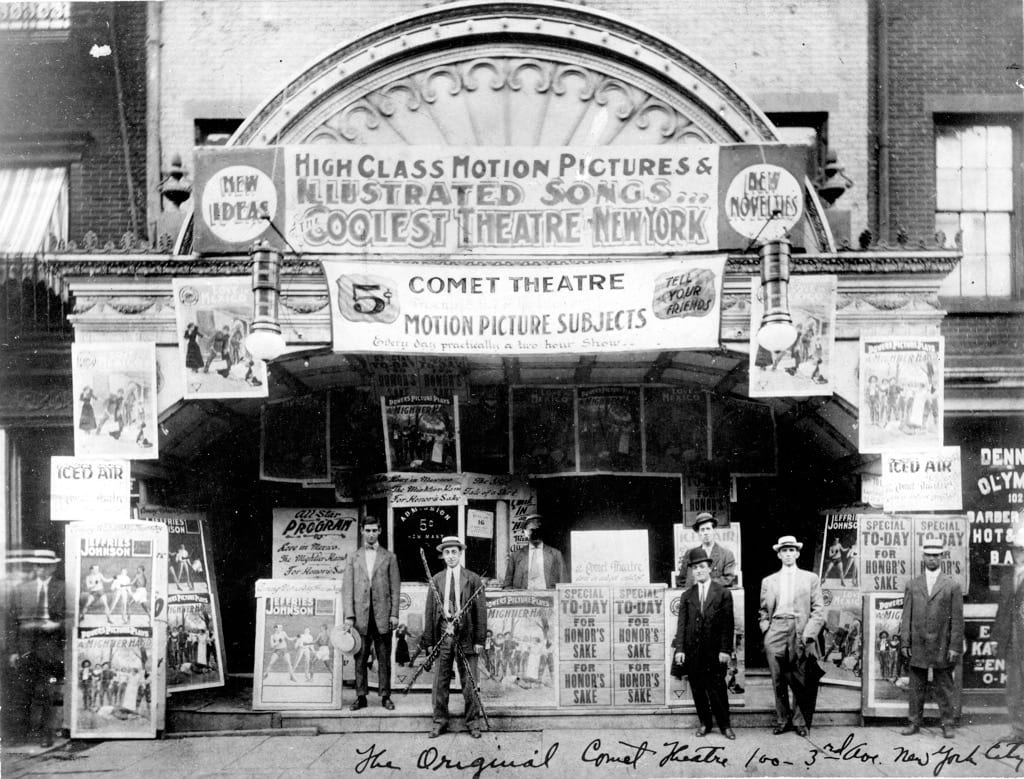A selection of silent films with new scores by NYU Screen Scoring Program students. Professor Ron Sadoff, founding program director, and Dan Streible, NYU Cinema Studies, Orphan Film Symposium.
[The Comet] (Edison, 1910) 2 minutes
Cast: Anna Held (comet), Harry Watson (the earth)
George Kleine Collection, Library of Congress
Music composed and recorded by Andrew Goehring
additional vocals by Grace Carver
The Edison Mfg. Co. produced this oddball film on commission for Florenz Ziegfeld’s New York stage revue The Follies of 1910. Never released on its own, The Comet (the title assigned by LOC) appeared only as a projection behind performers singing a new novelty song “The Comet and the Earth” by Gus Edwards and Harry B. Smith. The comic turn was also topical, referring to the sensation created by Halley’s comet, which was visible to the human eye during April, May, and June 1910. The film, as it happens, was shot on May 18th, the date when the comet was nearest Earth.
Anna Held was among the most popular female stars on Broadway in the early twentieth century. A headliner of previous editions of the annual Follies, she was conspicuous in her absence from the 1910 production; she had recently broken off her “common-law marriage” with producer Florenz Ziegfeld Jr. Her face –with its famously large, seductive eyes — appearing on the screen made for Held’s surprise appearance in the production.
Andrew Goehring’s inventive new score captures the delightful novelty and flirtatious whimsy that viewers no doubt experienced when the multimedia act debuted at the New York Theatre in June 1910.
An excellent account of this film is in Gwendolyn Waltz’s essay “20 Minutes or Less: Short-Form Film-and-Theatre Hybrids: Skits, Sketches, Playlets, & Acts in Vaudeville, Variety, Revues, &c.,” in Performing New Media, 1890-1915, ed. Joshua Yumibe et al, (Indiana University Press, 2014).
Postscript:
The vogue for all things Comet Halley in 1910 includes this bit of film history. That summer a quintessential nickelodeon changed its name to the Comet Theatre.
My book Fight Pictures: A History of Boxing and Early Cinema (2008), captions this photo thusly: “The men of the Comet Theatre, a downtown New York nickelodeon, display posters for Jeffries-Johnson Fight Pictures as part of their exhibition of ‘high class motion pictures.’ (Daniel Blum Collection, Wisconsin Center for Film and Theater Research.)”

Robert Sklar’s Movie-Made America: A Cultural History of American Movies (1975/1994) captions the photo this way: “New York’s early movie district clustered around Union Square. . . . The Comet Theatre at 100 Third Avenue, between Twelfth and Thirteenth. By the 1930s the Comet had become the Lyric, and in 1974 it was still operating — as the Jewel, showing male homosexual films. (Quigley Photographic Archive, Georgetown University Library).”
Both books missed or omitted the fact that it was the appearance of Halley’s comet in 1910 that prompted the name.